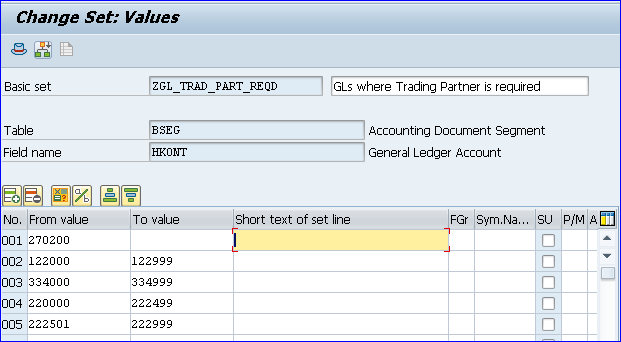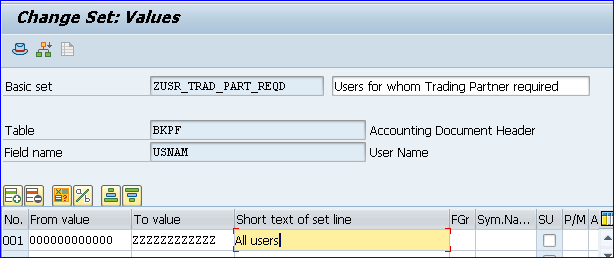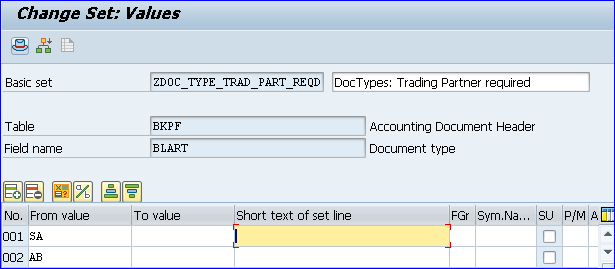By Ashish Sampat

This is Part II of Make Trading Partner a Required Entry Part I
Can You Make Trading Partner Required While Posting Financial Documents?
You have three alternatives:
1) Field Status Group
Field status groups can be used to make certain fields required, optional, displayed, or suppressed using field status definitions. However, trading partners are not available in the field status group.
The trading partner field VBUND and data element RASSC can be enabled in the field status group by adding them to table TCOBF Coding Block: Assignment of Modif and Field Names from COBL. With this change, field status groups can be leveraged to influence the Trading Partner status (suppressed, required, or optional). However, this option is not recommended by SAP. It may create inconsistencies while posting FI documents (SAP Note 1397715 - Adding VBUND to the coding block-2)
- Transaction OBC4 - Field Status variants - GL Account level
- Transaction OB41 - Field Status Groups - Posting Key level
2) Document Type
Document types can be configured so that trading partner is available for input. The following fields need to be activated in document type:
Transaction OBA7 - Document Types Table T003
o Partner Company can be input T003-XMGES
o Cross-company T003-XGSUB
This setup will open up trading partners at the document level. However, it does not make trading partners a required entry.
3) FI Validation
FI validation can prevent document postings where the trading partner is missing for certain GL accounts. A validation in FI has three sections: Pre-requisite, Check, and Message. These sections are explained below with examples.
- Transaction OB28 - Financial Accounting validation configuration transaction
- Transaction GS01 - Create set master data transaction, generally not transported
- Transaction GS02 - Change set master data transaction, generally not transported
Prerequisite:
For certain set of accounts defined in set ZGL_TRAD_PART_REQD figure 2
For certain sets of users defined in set ZUSR_TRAD_PART_REQD, figure 3
For certain document types defined in set ZDOC_TYPE_TRAD_PART_REQD, figure 4
Check:
If Trading Partner is blank
Message:
Return an error with an appropriate message
The implication of this validation is that the user cannot proceed with this transaction until the trading partner is entered.
Conclusion
With the shortcomings of the Field Status Group and Document Type options, these two options are generally not preferred.
FI validations are easy to configure and maintain. They generally do not require ABAP programming unless a user-exit or table-lookup is needed.
A simple validation like the one shown in this example can ensure data consistency and accuracy.

Figure 1: OB28 - FI Validation for missing Trading Partner for GL Accounts, Users, and Document Types
Prerequisite:
BSEG-HKONT IN ZGL_TRAD_PART_REQD AND
BKPF-USNAM IN ZUSR_TRAD_PART_REQD AND
BKPF-BLART IN ZDOC_TYPE_TRAD_PART_REQD
Check:
BSEG-VBUND <> ''
Message:
Error Z1 032 Trading Partner is required for GL

Figure 2: GS01 / GS02 - Create / Maintain Set to define GL Accounts checked for Trading Partner

Figure 3: GS01 / GS02 - Create / Maintain Set to define Users to be checked for Trading Partner

Figure 4: GS01 / GS02 - Create / Maintain Set to define Document Types to be checked
This is Part II of Make Trading Partner a Required Entry Part I
Reference:
SAP Note 1397715 - FI - Adding VBUND to the coding block
Glossary
Activity Type
An activity type identifies activities provided by a cost center to manufacturing orders. The secondary type general ledger account associated with an activity type identifies the activity costs on cost center and detailed reports.
Cost Center
A cost center is master data that identifies where the cost occurred. A responsible person assigned to the cost center analyzes and explains the cost center variances at the end of each period.
FBL3N - G/L Account Line Item Display
FBl3N displays G/L line items. It displays the G/L line items only for the G/L accounts that have the 'Display Line Item' checkbox selected.
F.13 - Automatic Clearing
You use Transaction F.13 to post automatic clearing.
F.19 - Analyze GR/IR Account and Accrual
F. 19 analyzes the GR/IR clearing account and posts adjustment entries for outstanding amounts to adjustment accounts. It makes the offsetting entry to the account for goods delivered but not invoiced or to the account for goods invoiced but not delivered.
FS10N - G/L Account Balance Display
This report allows you to view the totals of a single or a range of G/L accounts.
Trading Partner
One of the two or more participants in an ongoing business relationship.
Material Master
A material master contains all of the information required to manage a material. Information is stored in views, and each view corresponds to a department or area of business responsibility. Views conveniently group information together for users in different departments, for example, sales and purchasing.
Origin Group
An origin group separately identifies materials assigned to the same cost element, allowing them to be assigned to separate cost components. The origin group can also determine the calculation base for overhead in costing sheets.
Price Control
The Price control field in the Costing 2 view determines whether inventory is valuated at standard or moving average price.
Price Unit
The price unit refers to the number of units to which the price applies. You can increase the accuracy of the price by increasing the price unit. To determine the unit price, divide the price by the price unit.
Process Order
Process orders are used for the production of materials or the provision of services in a certain quantity and on a certain date. They enable the specification of resource planning, process order management control, account assignment, and order settlement rules.
Procurement Alternative
A procurement alternative represents one of several methods for procuring a material. You can control the level of detail in which the procurement alternatives are represented through the controlling level. Depending on the processing category, there are single-level and multilevel procurement alternatives. For example, a purchase order is a single-level procurement, whereas production involves multilevel procurement.
Production Order
A production order is used for discrete manufacturing. A BOM and routing are copied from the master data to the order. A sequence of operations is provided by the routing, which describes how to perform the work steps.
An operation can refer to a work center at which it is to be performed. An operation contains planned activities required to carry out the operation. Costs are based on the material components and activity price multiplied by a standard value.
Product Drilldown Reports
Product drilldown reports allow you to slice and dice data based on characteristics such as product group, material, plant, cost component, and period. Product drilldown reports are based on predefined summarization levels and are relatively simple to set up and run.
Production Variance
Production variance is a type of variance calculation that measures the difference between the net actual costs debited to the order and the target costs based on the preliminary cost estimate and the quantity delivered to inventory. You calculate production variance with target cost version 1. Production variances are provided for informational purposes only and are not relevant to settlement.
Production Version
A production version determines which alternative Bill of Materials (BOM) is used, along with which task list or master recipe, to produce a material or create a master production schedule. For one material, you can have multiple production versions with varying validity periods and lot size ranges.
Purchase Price Variance
When raw materials are valued at the standard price, a purchase price variance will post during goods receipt if the goods receipt or invoice price is different from the material standard price.
Profitability Analysis
Costing-based profitability analysis enables you to evaluate market segments, which can be classified according to products, customers, orders (or any combination of these), or strategic business units, such as sales organizations or business areas concerning your company?s profit or contribution margin.
Profit Center
SAP Profit Center is a management-oriented organizational unit used for internal controlling purposes. Segmenting a company into profit centers allows us to analyze and delegate responsibility to decentralized units.
Purchasing Info Record
A purchasing info record stores all the information relevant to the procurement of a material from a vendor. It contains the Purchase Price field, which the standard cost estimate searches for when determining the purchase price.
Raw Materials
Raw materials are always procured externally and then processed. A material master record of this type contains purchasing data but not sales.
Routing
A routing is a list of tasks containing standard activity times required to perform operations to build an assembly. Routings, along with planned activity prices, provide cost estimates that include the necessary information to calculate labor and activity costs for products.
Sales and Operations Planning
Sales and operations planning (SOP) enables you to create a sales plan, convert it into a production plan, and then transfer the plan to long-term planning.
S&OP is slowly being replaced by SAP Integrated Business Planning for Supply Chain (SAP IBP), which supports all S&OP features. S&OP is intended as a bridge or interim solution, allowing for a smooth transition from SAP ERP to on-premise SAP S/4HANA and SAP IBP. Please refer to SAP Note 2268064 for further details.
SAP Fiori
SAP Fiori is a web-based interface that serves as an alternative to the SAP GUI. SAP Fiori apps access the Universal Journal directly, leveraging additional fields such as the work center and operation for enhanced variance reporting.
Settlement
Work-in-process (WIP) and variances are transferred to Financial Accounting, Profit Center Accounting (PCA), and Profitability Analysis (CO-PA) during the settlement process. Variance categories can also be transferred to value fields in CO-PA.
Settlement Profile
A settlement profile contains the parameters necessary to create a settlement rule for manufacturing orders and product cost collectors and is contained in the order type.
Settlement Rule
A settlement rule determines which portions of a sender's costs are allocated to which receivers. A settlement rule is contained in a manufacturing order or product cost collector header data.
Setup Time
You need setup time to prepare equipment and machinery for the production of assemblies, and that preparation is generally the same regardless of the quantity produced. Setup time spread over a smaller production quantity increases the unit cost.
Simultaneous Costing
The process of recording actual costs for cost objects, such as manufacturing orders and product cost collectors in cost object controlling, is called simultaneous costing. Costs typically include goods issues, receipts to and from an order, activity confirmations, and external service costs.
Source Cost Element
Source cost elements identify costs that debit objects, such as manufacturing orders and product cost collectors.
Source List
A source list is a list of available sources of supply for a material, which indicates the periods during which procurement is possible. Typically, a source list is a compilation of quotations for materials from various vendors.
You can specify a preferred vendor by selecting the 'Fixed Source of Supply' indicator. If you do not select this indicator for any source, a cost estimate will choose the source with the lowest cost as the cost of the component. You can also indicate which sources are relevant to MRP.
Standard Price
The standard price in the Costing 2 view determines the inventory valuation price when price control is set at standard (S). The standard price is updated when a standard cost estimate is released. You normally value manufactured goods at the standard price.
Subcontracting
You supply component parts to an external vendor who manufactures the complete assembly. The vendor has previously supplied a quotation, which is entered in a purchasing info record with a category of subcontracting.
Tracing Factor
Tracing factors determine the cost portions received by each receiver from senders during periodic allocations, such as assessments and distributions.
Universal Journal
The efficiency and speed of the SAP HANA in-memory database enabled the introduction of the Universal Journal, featuring single-line-item tables, as well as ACDOCA (actual) and ACDOCP (plan). The Universal Journal enables the consolidation of all postings from the previous financial and controlling components into a single item. The many benefits include the development of real-time accounting. In this book, we discuss both period-end and event-based processing.
Valuation Class
The valuation class in the Costing 2 view determines which general ledger accounts are updated as a result of inventory movement or settlement.
Valuation Date
The valuation date determines which material and activity prices are selected when you create a cost estimate. Purchasing info records can contain different vendor-quoted prices for different dates. Different plan activity rates can be entered per fiscal period.
Valuation Grouping Code
The valuation grouping code allows you to assign the same general ledger account assignments across several plants with Transaction OMWD to minimize your work.
The grouping code can represent one or a group of plants.
Valuation Type
You use valuation types in the split valuation process, which enables the same material in a plant to have different valuations based on criteria such as batch. You assign valuation types to each valuation category, which specify the individual characteristics that exist for that valuation category. For example, you can valuate stocks of a material produced in-house separately from stocks of the same material purchased externally from vendors. You then select procurement type as the valuation category and internal and external as the valuation types.
Valuation Variant
The valuation variant is a costing variant component that allows different search strategies for materials, activity types, subcontracting, and external processing. For example, the search strategy for purchased and raw materials typically searches first for a price from the purchasing info record.
Valuation Variant for Scrap and WIP
This valuation variant allows a choice of cost estimates to valuate scrap and WIP in a WIP at target scenario. If the structure of a routing is changed after a costing run, WIP can still be valued with the valuation variant for scrap and WIP, resulting in a more accurate WIP valuation.
Valuation View
In the context of multiple valuation and transfer prices, you can define the following views:
- Legal valuation view
- Group valuation view
- Profit center valuation view
Work Center
Operations are carried out at work centers, which encompass various elements, including machines, production lines, and employees. The work center master data contains a mandatory cost center field. A work center can be linked to only one cost center, whereas a cost center can be linked to multiple work centers.
Work in Process
Work in process (WIP) represents production costs of incomplete assemblies. For balance sheet accounts to accurately reflect the company's assets at the end of the period, WIP costs are temporarily moved to the WIP balance sheet and profit and loss accounts. WIP is canceled during period-end processing following the delivery of assemblies to inventory.
Document Type
The document type is a key that is used to classify accounting documents and distinguish between business transactions to be posted. The document type is entered in the document header and applies to the whole document.
Field Status Group
The Field Status Group is used to manage the fields of the required object. If the field status group is defined for a general ledger master, it's defined to manage the fields to be used when creating the master data.
FI Validations
FI validations allow you to create your own Boolean statements without making any changes to the standard system. A validation can consist of up to 999 steps. You can, therefore, validate data against any number of Boolean statements before the data is posted.

